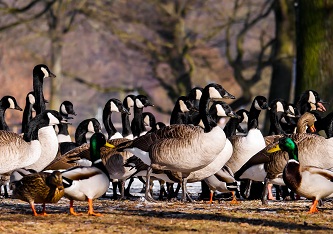Avian Influenza
Information on Bird Flu and its Effects on Bird Populations
 Highly pathogenic avian influenza (HPAI) A (H5N1) is a virus that occurs mainly in wild birds including ducks, geese, turkeys, swans, and gulls but rarely causes them to become ill. The main risk of the virus is to domestic poultry such as chickens, turkeys, quail, and ducks.
Highly pathogenic avian influenza (HPAI) A (H5N1) is a virus that occurs mainly in wild birds including ducks, geese, turkeys, swans, and gulls but rarely causes them to become ill. The main risk of the virus is to domestic poultry such as chickens, turkeys, quail, and ducks.
The HPAI Eurasian H5 virus has been detected in several states in 2022 including South Carolina, Virginia, and New Hampshire. These birds appeared healthy but may be spreading the virus to other birds. Samples in New Hampshire were taken as part of routine monitoring by NH Fish and Game and tested by the US Department of Agriculture Animal (USDA) and Plant Health Inspection Service (APHIS). Occasionally avian flu has been known to infect people but no illness has been detected in humans from this strain of the disease to date.
In 2015, HPAI subtype H5N2 was associated with a large domestic poultry outbreak in North America. At that time the virus was also detected in wild birds and was associated with mortality in some species, but it is not common. The concern is for the spread of the virus from wild birds to domestic ones, such as backyard chicken flocks. There are many strains of avian influenza that affect birds, and they are generally classified as HPAI or LPAI, for low pathogenic avian influenza.



